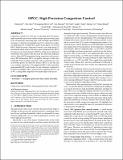HPCC: high precision congestion control
Author(s)
Li, Yuliang; Miao, Rui; Liu, Hongqiang Harry; Zhuang, Yan; Feng, Fei; Tang, Lingbo; Cao, Zheng; Zhang, Ming; Kelly, Frank; Alizadeh, Mohammad; Yu, Minlan; ... Show more Show less
DownloadAccepted version (1.493Mb)
Open Access Policy
Open Access Policy
Creative Commons Attribution-Noncommercial-Share Alike
Terms of use
Metadata
Show full item recordAbstract
© 2019 Association for Computing Machinery. Congestion control (CC) is the key to achieving ultra-low latency, high bandwidth and network stability in high-speed networks. From years of experience operating large-scale and high-speed RDMA networks, we find the existing high-speed CC schemes have inherent limitations for reaching these goals. In this paper, we present HPCC (High Precision Congestion Control), a new high-speed CC mechanism which achieves the three goals simultaneously. HPCC leverages in-network telemetry (INT) to obtain precise link load information and controls traffic precisely. By addressing challenges such as delayed INT information during congestion and overreaction to INT information, HPCC can quickly converge to utilize free bandwidth while avoiding congestion, and can maintain near-zero in-network queues for ultra-low latency. HPCC is also fair and easy to deploy in hardware. We implement HPCC with commodity programmable NICs and switches. In our evaluation, compared to DCQCN and TIMELY, HPCC shortens flow completion times by up to 95%, causing little congestion even under large-scale incasts.
Date issued
2019-08Department
Massachusetts Institute of Technology. Department of Electrical Engineering and Computer Science; Massachusetts Institute of Technology. Computer Science and Artificial Intelligence LaboratoryJournal
SIGCOMM 2019 - Proceedings of the 2019 Conference of the ACM Special Interest Group on Data Communication
Publisher
Association for Computing Machinery (ACM)
Citation
Li, Yuliang, Miao, Rui, Liu, Hongqiang Harry, Zhuang, Yan, Feng, Fei et al. 2019. "HPCC: high precision congestion control." SIGCOMM 2019 - Proceedings of the 2019 Conference of the ACM Special Interest Group on Data Communication.
Version: Author's final manuscript